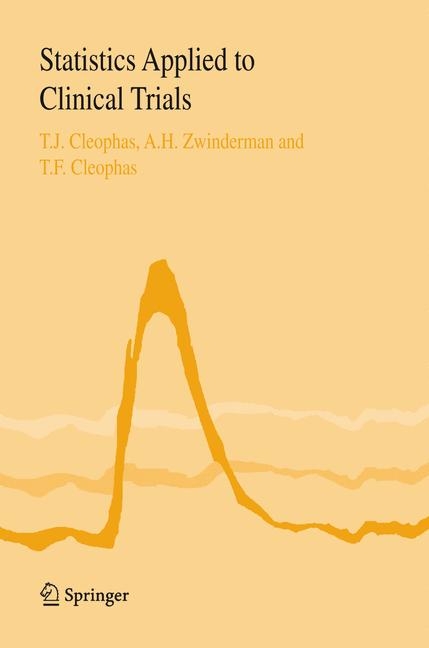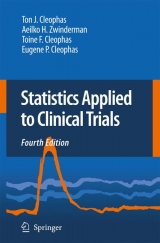
Statistics Applied to Clinical Trials
Springer-Verlag New York Inc.
978-1-4020-4229-4 (ISBN)
- Titel erscheint in neuer Auflage
- Artikel merken
In 1948, the first randomized controlled trial was published by the English Medical Research Council in the "British Medical Journal". Until then, observations had been uncontrolled. Initially, trials frequently did not confirm hypotheses to be tested. This phenomenon was attributed to little sensitivity due to small samples, as well as inappropriate hypotheses based on biased prior trials. Additional flaws were being recognized and subsequently better accounted for. Such flaws of a mainly technical nature have been largely implemented and after 1970 led to trials being of significantly better quality than before. The past decade focused, in addition to technical aspects, on the need for circumspection in the planning and conducting of clinical trials. As a consequence, prior to approval, clinical trial protocols are now routinely scrutinized by different circumstantial organs, including ethics committees, institutional and federal review boards, national and international scientific organizations, and monitoring committees charged with conducting interim analyses.
This third edition not only explains classical statistical analyses of clinical trials, but addresses relatively novel issues, including equivalence testing, interim analyses, sequential analyses, meta-analyses, and provides a framework of the best statistical methods currently available for such purposes.
Foreword
Chapter 1: Hypotheses, Data, Stratification
Chapter 2: The Analysis of Efficacy Data
Chapter 3: The Analysis of Safety Data
Chapter 4: Log Likelihood Ratio Tests for Safety Data Analysis
Chapter 5: Equivalence Testing
Chapter 6: Statistical Power and Sample Size
Chapter 7: Interim Analyses
Chapter 8: Clinical Trials Are Often False Positive
Chapter 9: Multiple Statistical Inferences
Chapter 10: The Interpretation of the P-Values
Chapter 11: Research Data Closer to Expectation than Compatible with Random Sampling
Chapter 12: Statistical Tables for Testing Data Closer to Expectation than Compatible with Random Sampling
Chapter 13: Principles of Linear Regression
Chapter 14: Subgroup Analysis Using Multiple Linear Regression: Confounding, Interaction, Synergism
Chapter 15: Curvilinear Regression
Chapter 16: Logistic and Cox Regression, Markow Models, Regression with Laplace Transformations
Chapter 17: Regression Modeling For Improved Precision
Chapter 18: Post-Hoc Analysis in Clinical Trials, A Case For Logistic Regression Analysis
Chapter 19: Confounding
Chapter 20: Interaction
Chapter 21: Meta-Analysis, Basic Approach
Chapter 22: Meta-Analysis, Review and Update of Methodologies
Chapter 23: Crossover Studies with Continuous Variables
Chapter 24: Crossover Studies with Binary Responses
Chapter 25: Cross-Over Trials Should Not Be Used To Test Treatments with Different Chemical Class
Chapter 26: Quality-Of-Life Assessments in Clinical Trials
Chapter 27: Statistics for the Analysis of Genetic Data
Chapter 28: Relationship among Statistical Distributions
Chapter 29: Testing Clinical Trials for Randomness
Chapter 30: Clinical Trials Do Not Use Random Samples Anymore
Chapter 31: Clinical Data Where Variability Is More Important than Averages
Chapter 32: Testing Reproducibility
Chapter 33: Validating Qualitative Diagnostic Tests
Chapter 34: Uncertainty of Qualitative Diagnostic Tests
Chapter 35: Meta-Analyses of Qualitative Diagnostic Tests
Chapter 36: Validating Quantitative Diagnostic Tests
Chapter 37: Summary of Validation Procedures for Diagnostic Tests
Chapter 38: Validating Surrogate Endpoints of Clinical Trials
Chapter 39: Methods for Repeated Measures Analysis
Chapter 40: Advanced Analysis Of Variance, Random Effects and Mixed Effects Models
Chapter 41: Monte Carlo Methods for Data Analysis
Chapter 42: Physicians’ Daily Life and the Scientific Method
Chapter 43: Superiority-Testing
Chapter 44: Trend-Testing
Chapter 45: Odds Ratios and Multiple Regression, Why and How to Use Them
Chapter 46: Statistics Is No "Bloodless" Algebra
Chapter 47: Bias Due to Conflicts of Interests, Some Guidelines
Appendix
Index
| Erscheint lt. Verlag | 21.12.2005 |
|---|---|
| Zusatzinfo | XV, 366 p. |
| Verlagsort | New York, NY |
| Sprache | englisch |
| Maße | 155 x 235 mm |
| Gewicht | 717 g |
| Themenwelt | Mathematik / Informatik ► Mathematik ► Wahrscheinlichkeit / Kombinatorik |
| Medizin / Pharmazie ► Medizinische Fachgebiete ► Pharmakologie / Pharmakotherapie | |
| Studium ► Querschnittsbereiche ► Epidemiologie / Med. Biometrie | |
| ISBN-10 | 1-4020-4229-9 / 1402042299 |
| ISBN-13 | 978-1-4020-4229-4 / 9781402042294 |
| Zustand | Neuware |
| Haben Sie eine Frage zum Produkt? |
aus dem Bereich



